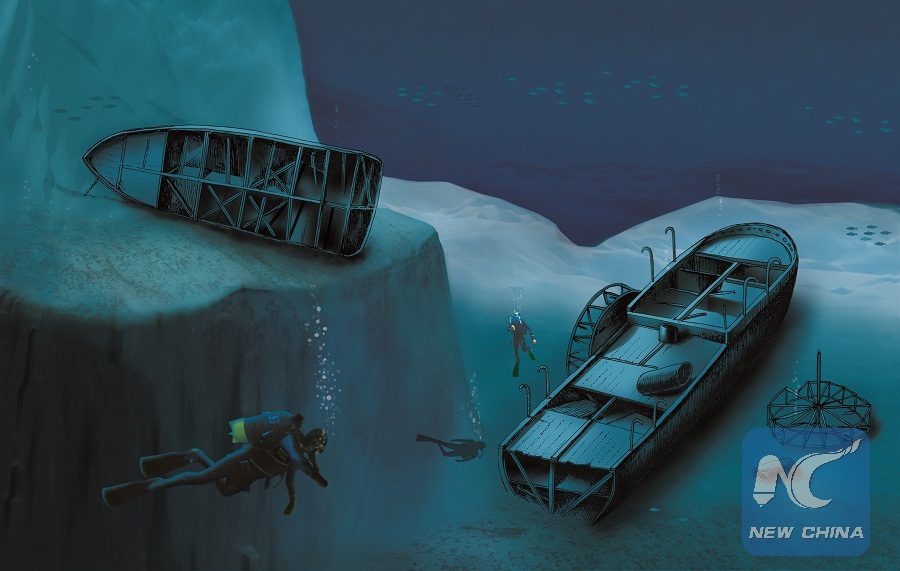
Computer-generated image shows the archaeological excavation scene of an ancient shipwreck. (Photo courtesy of the Ephorate of Underwater Antiquities)
by Konstantinos Tzikas, Vassilis Vafidis
ATHENS, Aug. 29 (Xinhua) -- Lacking funds partly because of the debt crisis, Greece which is rich in underwater antiquities, is now working closely with archaeological groups from other countries to explore, preserve and display the treasure trove.
Located in the heart of the old town of Athens, stands the Ephorate of Underwater Antiquities (EUA). This elegant building of neoclassical style houses almost all of the antiquities discovered in various bodies of water in Greece -- sea, lakes and rivers.
A wealth of statues, urns, busts, coins and other remarkable findings are painstakingly cleaned and preserved here, before they can be exposed to the public.
Founded in 1976, the EUA is a special subdivision of the Greek Ministry of Culture and is tasked with the preservation of underwater antiquities.
The recession in the last few years has struck the EUA hard. It is now working closely together with other countries. Archaeological operations include islands such as Delos, Ikaria, Naxos, Skiathos and Crete.
The most famous underwater excavation currently in progress is the Antikythera wreck. Dating from the second quarter of the first century BC, this Roman shipwreck was discovered by sponge divers off the Greek island of Antikythera in 1900.
Found in the wreck were numerous statues, coins and other artifacts, as well as the remains of the device commonly considered to be the world's first analog computing device, the Antikythera mechanism.
Since 2014, the EUA has been collaborating with the Woods Hole Oceanographic Institution from the United States. The team completed an underwater circumnavigation of Antikythera, documented several isolated finds, relocated the Antikythera wreck, and identified a second ancient shipwreck, a few hundred meters south of the wreck. The Woods Hole Oceanographic Institution supports the EUA both on equipment and know-how.
"The water (in the wreck) is very deep, about 50 meters, hence we can't approach the underwater findings via conventional diving. It requires technical diving, which few of those employed in the Ephorate are familiar with,"Angeliki Simosi, the archaeologist and head of the EUA, told Xinhua.
The laboratory staff of the EUA is working on a number of findings, including the bronze head of a youth, a spear from the Antikythera wreck, and numerous urns.

An image made on 30 June, 2011 shows some underwater archaeological objects. (Photo courtesy of the Ephorate of Underwater Antiquities)
"I'm standing before a bronze statue. It is a cuirassed rider of the late Hellenistic Period. It was found at sea between the Kos and Kalymnos islands. You can see how remarkably it has been preserved by the EUA's staff. See how wonderfully made is both the cuirass and the tunic of the rider," Simosi told Xinhua, presenting the most impressive recent finding of the EUA.
As the laboratory gradually became overcrowded with new finds, the EUA recently acquired a second laboratory. There, findings from the shipwrecks can be desalinized, also known as scaling, which means striping salt and other excess material accumulated on the object's surface and interior over the years.
"The most important stage in the preservation of underwater antiquities is the process of desalination. It is a time-consuming process, during which all incoming findings are placed in water tanks. This process can take up to a year. The time needed depends on the volume of the object involved and how extensive the scaling on the object is," preserver Spyridoula Papanikou, who has been working with the EUA since 2007, told Xinhua.
Preservation is a long and often arduous process. Papanikou showed a process of mechanical cleaning for an urn found in a Mycenaean shipwreck. "We must slowly remove all the scaling and finally reach the original surface of the urn, using either a scrapper or a pneumatic tool," she said.

Photo taken on 17 October, 2013 shows a piece of underwater antiquity. (Photo courtesy of the Ephorate of Underwater Antiquities)
Fellow preserver Theoni Dimitropoulou shared another exciting new find, which she has been cleaning under the microscope for several months.
"We are working on a Roman shipwreck, a collection of 35,000 silver-plated coins. Because this is a complex object, we resort to a combination of both chemical and mechanical cleaning in order to reveal the surface," Dimitropoulou said.
In spite of all the difficulties involved, the EUA has big plans for the future. The foundation of a number of Underwater Museums, which will allow the dazzling variety of findings to be exhibited to the public, is underway.
"Our basic priority is to create the Museum of Underwater Antiquities. Its planned location was the Piraeus Cultural Coast," said Simosi.

